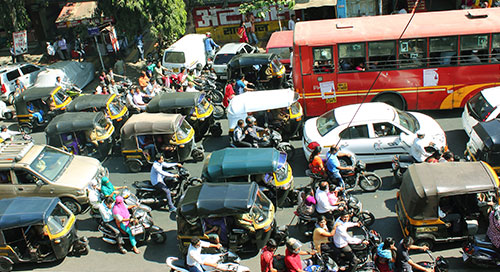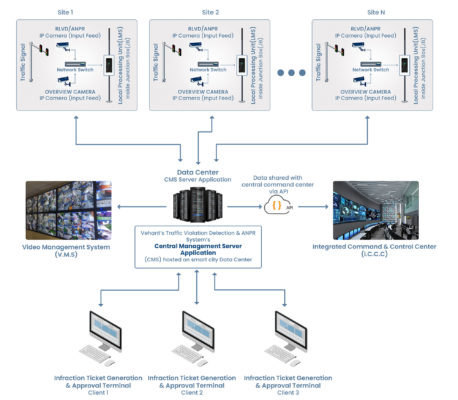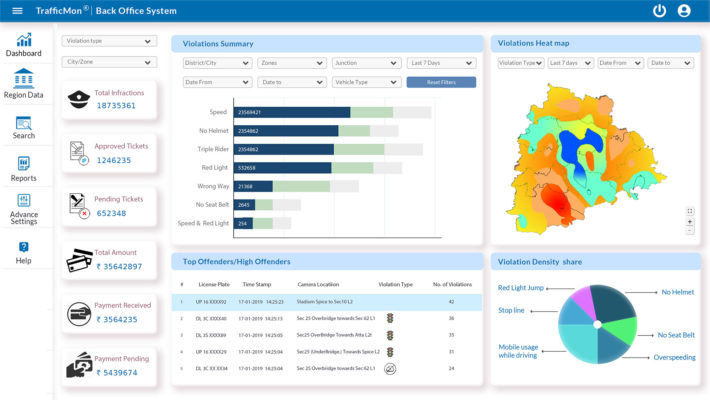Enhance Traffic Enforcement with AI and Computer Vision

Editor’s Note: insight.tech stands in support of ending acts of racism, inequity, and social injustice. We do not tolerate our sponsors’ products being used to violate human rights, including but not limited to the abuse of visualization technologies by governments. Products, technologies, and solutions are featured on insight.tech under the presumption of responsible and ethical use of artificial intelligence and computer vision tools, technologies, and methods.
With millions of registered vehicles—and growing every day—the authorities of a city in southern India struggled with managing traffic in already overcrowded streets. The combination of outdated technology and overburdened traffic officers was costly, dangerous, and not scalable.
What the city needed was a modern solution that could scale to its needs. This included not just detecting them but also giving authorities the capability to see a detailed review before violations were transmitted within the system for ticket generation.
The good news is that combining technologies such as computer vision and artificial intelligence (AI) puts cost-effective, citywide traffic law enforcement within reach.
Scalable Traffic Management
Vehant TrafficMon® solutions add an intelligence layer to standard IP cameras, which allow detection of multiple types of infractions—while license plate recognition identifies violators. In addition, real-time analytics and its visualization help authorities showcase current conditions and trends across the city, enabling traffic managers to take action proactively.
Vehant’s Traffic Monitoring and Junction Enforcement Solutions include a set of software modules with detection capabilities such as:
- Automatic number plate recognition (ANPR)
- Red-light violation
- Triple bike riding and no-helmet violation
- Speed violation
- Wrong-way driving
- Free left-turn obstruction
- Color and logo
Not only can authorities add cameras at a number of locations, they can start with one application and add more capabilities down the road. This scalability helps cities focus on their critical needs while getting more value out of their existing infrastructure.
“Video processing, robust deep learning algorithms, and edge-AI hardware are the brains of the system,” said Dheeraj Saxena, Business Development Manager, Vehant. “These capabilities enable both capturing events as they happen and analytics for extracting key insights and effective resource planning.”
This also allows for all sorts of actionable information, such as the regions with highest violations, repeat offenders, and hot-listed vehicles. Violation trend analysis also help authorities better understand sociocultural behavior.
“Video processing, robust deep learning algorithms, and edge-AI hardware are the brains of the system.”
—Dheeraj Saxena, Vehant.
Computer Vision and AI at the Edge
The majority of the heavy lifting gets done at the local processing units (LPUs).
“The feed from the cameras comes into the LPU,” said Anoop Prabhu, Chief Technology Officer, Vehant. “And this is where the processing of raw frames, including AI models, takes place in order to understand what’s really going on—the infractions that are happening in the moment.” From there, only the information that relates to an infraction is sent to the back-end server from across all the cities and junctions, where it then gets consolidated (Figure 1).

Data collected at the edge lets the city not just identify violation activity but also take a proactive approach to improving road safety.
With the Intel® OpenVINO™ Toolkit, Vehant’s AI and ML processing work in real time on Intel® platforms. “Working closely with Intel has enabled us to adapt our computation-intensive applications, ensuring seamless operations on their processors,” said Prabhu.
In the data center, a central management server application receives all the data from across the edge devices. This valuable data feed is passed on to a command center via an API to provide relevant information (Figure 2).

Architecting a Smart Traffic Enforcement and Management Solution
From planning to implementation, system integrators (SIs) work with cities and Vehant to deploy the right solutions in the right locations. With their domain knowledge, they are well suited to help traffic managers plan the system architecture and infrastructure required to cover roadways, intersections, and hot spots.
This includes where cameras will be mounted and edge devices located for optimal coverage. SIs can design the network infrastructure that connects the edge computing devices back to the main server.
“Our flexible and modular solution architecture allows horizontal and vertical scaling, and new software modules can be easily added to leverage existing camera infrastructure,” said Kapil Bardeja, Co-founder & CEO, Vehant. “And this helps SIs streamline the deployment and scale up projects.”
For authorities such as traffic police and urban city planners, deployment of these technologies results in real benefits for citizens and authorities alike:
- Effective traffic enforcement
- Better road safety
- Reduced congestion
- Smoother traffic flow
- Insights for city infrastructure planning
When it comes to traffic management, smart cities are getting even smarter.